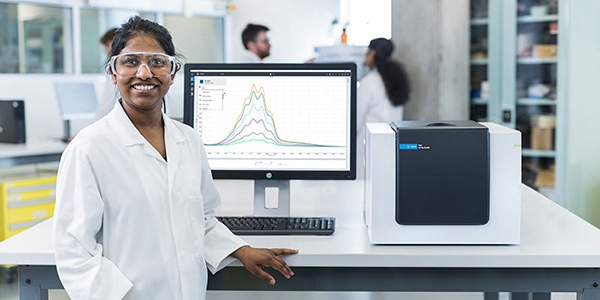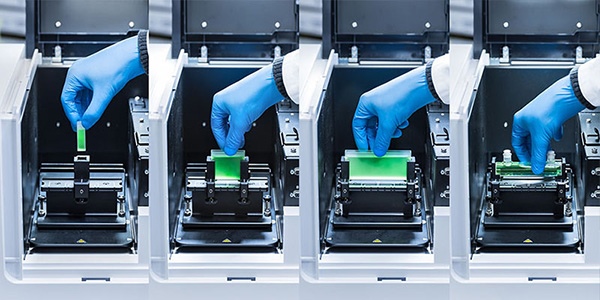
The Cary 3500 UV-Vis spectrophotometer already made waves upon release back in 2018, with its unique modular interface. Users could pick and choose which modules to get according to their needs, and the ability to quickly swap between modules without needing tools or alignment tore down any technical hurdles normally associated with swapping UV-Vis accessories.
Compact and Multicell modules
While the original compact module (2 cuvette positions) provided a good foundation for routine analyses, the multicell module absolutely set a new standard with 8 cuvette positions and no moving parts; all 8 cells are measured simultaneously for the highest sample throughput. These two modules are available in ambient or fast air-cooled temperature-controlled versions (-5 to 100oC, no circulating fluid required), making for another fantastic feature on an already excellent UV-Vis platform.
New Cary 3500 Flexible UV-Vis module
The most recent addition to the Cary 3500 UV-Vis module line-up is the Flexible module, a large dual beam sample compartment specifically designed to address some key analyses in the pharmaceutical market and beyond. This module now affords customers the ability to analyze large volume cuvettes up to 100 mm in length, as well as thin film solid samples, both engineered in the same tool-free fashion as all other modules. Routine analyses covering these two applications include the USP Ethanol Monograph as well as USP <671> for pharmaceutically regulated UV transmission of plastic packaging. However, the application reach of this new module extends far beyond these two analyses.

10-year lamp replacement warranty
A 10-year factory warranty on the xenon flash lamp powering the Cary 3500 UV-Vis (for new instruments purchased from Agilent or participating partners), brings this platform in line with identical warranties already available on our Cary 60 UV-Vis and Cary Eclipse fluorescence spectrophotometers. The peace of mind offered by lamps that can last over 10 years is a major asset for customers, as costs associated with instrument downtime from lamp maintenance alone can add up very quickly. All the more reason to absolve scientists of needless UV-Vis lamp changes!
New software features—plus OpenLab for compliance
Not satisfied with letting the hardware steal the show, our software design team has also added a few excellent new features to the Cary UV Workstation software. For example, the ability to add post-acquisition calculations using the powerful function-based Calculator feature—from about two dozen calculation types—has now been streamlined and is easier to employ than ever. These custom calculations are also saved as part of methods, thereby reducing dependency on manual, post-data acquisition calculations. This is especially useful for those using our compliant-capable OpenLab version of Cary UV Workstation (available as stand-alone or network-integrated solutions), as spectral data and calculation results will now automatically appear in the sample analysis report immediately after measurement. The software update is timed with the release of the Flexible module, but these new features are compatible with all Cary 3500 UV-Vis instruments.
Learn more at our Cary 3500 UV-Vis webinar
Overall, the Cary 3500 UV-Vis has been a huge step forward in UV-Vis instrument evolution, as many customers continue to attest. The new Flexible module adds fantastic functionality to an already robust UV-Vis arsenal, and all of us at Agilent can’t wait for you to see what we have in store next.
To hear more about the Cary 3500 Flexible UV-Vis spectrophotometer, join us for a live webinar in your time zone May 4-5, 2023.
Register to watch live or on-demand!

Further reading:
- Application note: Spectral Transmission Requirements for Plastic Pharmaceutical Packaging
- Application note: Pharmaceutical Analysis Using UV-Vis: Compliance with USP Chapter <857>, and Ph. Eur. 2.2.25
- Technical overview: Linear Dynamic Range of the Agilent Cary 3500 Flexible UV-Vis Spectrophotometer: Benefits of a Wide Dynamic Range
- Technical overview: Effortlessly Change Path Length to Enhance Photometric Performance
